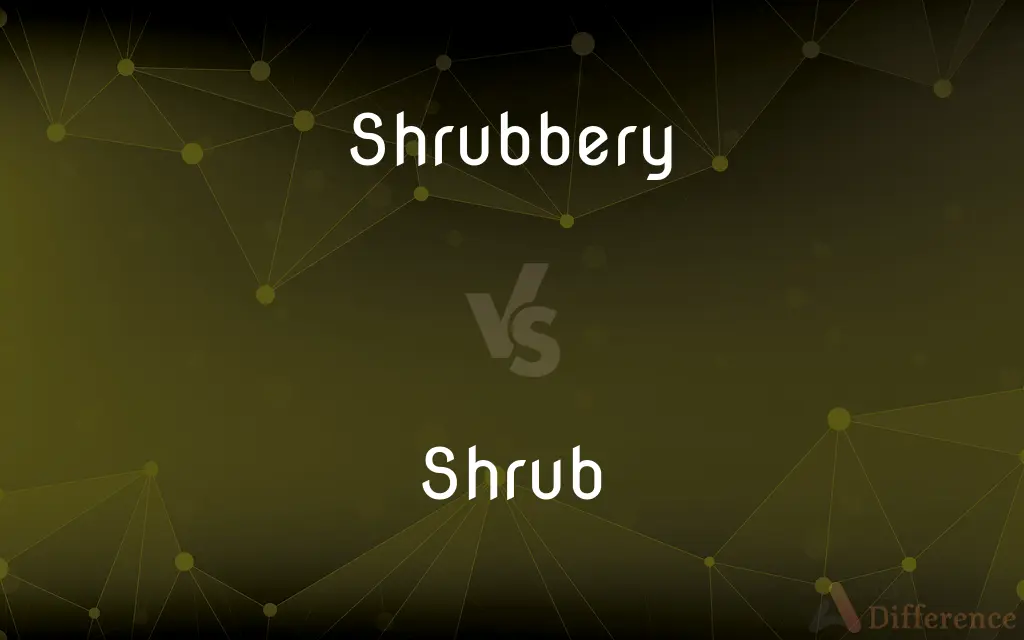Shrubbery vs. Shrub — What's the Difference?
By Fiza Rafique & Urooj Arif — Updated on April 2, 2024
Shrubbery refers to an area planted with shrubs, emphasizing the collective arrangement, while a shrub is a single, low-growing woody plant.

Difference Between Shrubbery and Shrub
Table of Contents
ADVERTISEMENT
Key Differences
A shrubbery is a landscaping feature that involves a collection or arrangement of shrubs, designed to enhance the aesthetic appeal of an outdoor space. It's often used to create natural borders, screens, or to add structure to garden designs. On the other hand, a shrub is an individual plant characterized by its woody stems and smaller height compared to trees. Shrubs can grow in a variety of environments and are a key element in both natural and cultivated landscapes.
Shrubberies are planned with a specific design in mind, incorporating different types of shrubs to achieve a particular look or function. These can range from formal arrangements to mimic walls or fences, to more naturalistic settings that encourage biodiversity. Whereas a shrub stands alone as a single entity, often serving as a foundational plant in gardens or as part of a mixed border.
The care and maintenance of a shrubbery involve considerations for the collective health and appearance of the arrangement, such as ensuring uniform growth, controlling pests and diseases, and maintaining the intended design. In contrast, caring for an individual shrub focuses on the needs of that specific plant, including pruning, watering, and fertilization based on its unique requirements.
Shrubberies can create microclimates within their bounds, offering shelter and habitat to a variety of wildlife, and can influence the microenvironment of a garden or landscape. A single shrub also contributes to the ecosystem by providing food and shelter for insects and birds, but on a smaller scale.
The selection of shrubs for a shrubbery might include considerations for color, texture, and seasonal interest to ensure the area remains visually appealing throughout the year. When choosing a single shrub, the decision may hinge more on the plant's individual characteristics, such as flower color, leaf shape, or growth habit, to complement the surrounding landscape.
ADVERTISEMENT
Comparison Chart
Definition
An area or feature composed of a collection of shrubs
A low-growing woody plant
Purpose
To enhance landscape aesthetics, create borders/screens
To provide structure, beauty, or utility in a landscape
Maintenance
Involves collective care for the arrangement
Focuses on the individual plant’s needs
Impact on Environment
Can create microclimates, supports more wildlife
Provides habitat and food on a smaller scale
Selection Criteria
Based on design, visual appeal, and biodiversity
Based on individual characteristics and compatibility
Compare with Definitions
Shrubbery
Landscaping element used for decoration or to delineate spaces.
We added a shrubbery along the walkway to create a natural boundary.
Shrub
A small to medium-sized woody plant.
The azalea shrub bloomed with vibrant colors each spring.
Shrubbery
A collective term for an area densely planted with shrubs.
The backyard’s shrubbery became a haven for birds and insects.
Shrub
Distinguished from trees by its multiple stems and shorter height.
Unlike the towering oak, the holly is a shrub that fits well under windows.
Shrubbery
A feature incorporating various shrubs for aesthetic or practical purposes.
The shrubbery at the entrance of the park was designed to welcome visitors with year-round color.
Shrub
Can serve as a foundational plant in landscape design.
The landscaper recommended adding a lilac shrub to the garden’s corner for fragrance.
Shrubbery
The practice of designing and maintaining arrangements of shrubs.
Shrubbery requires a good eye for design and knowledge of plant care.
Shrub
Thrives in a variety of environments, from deserts to wetlands.
The sagebrush shrub is well adapted to arid desert climates.
Shrubbery
A designed arrangement or collection of shrubs in a garden or landscape.
The garden's shrubbery provided a lush green backdrop for the annual outdoor concert.
Shrub
Used in gardens for its decorative leaves, flowers, or fruit.
We planted a butterfly bush shrub to attract wildlife.
Shrubbery
A shrubbery is a wide border to a garden where shrubs are thickly planted, or a similar larger area with a path winding through it, typical of the English landscape garden. A singular shrub is also known as a bush.
Shrub
A shrub (or bush, but this is more of a gardening term) is a small- to medium-sized perennial woody plant. Unlike herbaceous plants, shrubs have persistent woody stems above the ground.
Shrubbery
A group or planting of shrubs.
Shrub
A woody plant of relatively low height, having several stems arising from the base and lacking a single trunk; a bush.
Shrubbery
A planting of shrubs; a wide border to a garden where shrubs are thickly planted; or a similar larger area with a path winding through it.
Shrub
A beverage made from fruit juice, sugar, and a liquor such as rum or brandy.
Shrubbery
Shrubs collectively.
Shrub
A woody plant smaller than a tree, and usually with several stems from the same base.
Shrubbery
A collection of shrubs.
Shrub
(Kenyan English) A word mispronounced by replacing some consonant sounds with others of a similar place of articulation due to interference from one's knowledge of an indigenous Kenyan language.
Shrubbery
A place where shrubs are planted.
Shrub
A liquor composed of vegetable acid, fruit juice (especially lemon), sugar, sometimes vinegar, and a small amount of spirit as a preservative. Modern shrub is usually non-alcoholic, but in earlier times it was often mixed with a substantial amount of spirit such as brandy or rum, thus making it a liqueur.
Shrubbery
An area where a number of shrubs are planted
Shrub
(obsolete) To lop; to prune.
Shrubbery
A collection of shrubs growing together
Shrub
To mispronounce a word by replacing some consonant sounds with others of a similar place of articulation due to interference from one's knowledge of an indigenous Kenyan language.
Shrub
A liquor composed of vegetable acid, especially lemon juice, and sugar, with spirit to preserve it.
Shrub
A woody plant of less size than a tree, and usually with several stems from the same root.
Shrub
To lop; to prune.
Shrub
A low woody perennial plant usually having several major branches
Common Curiosities
How do you maintain a shrubbery?
Maintaining a shrubbery involves regular pruning, monitoring for pests and diseases, and ensuring the plants have adequate water and nutrients to support the collective design.
What considerations are important when designing a shrubbery?
Important considerations include the growth habits of the shrubs, seasonal appearance, color, texture, and how the arrangement complements the overall landscape design.
Why might a gardener choose to plant a shrubbery instead of a single shrub?
A gardener might plant a shrubbery for its design impact, to create natural borders or screens, or to enhance biodiversity in the garden.
Can shrubberies include plants other than shrubs?
While the focus is on shrubs, shrubberies can also incorporate other elements like perennials or ornamental grasses to add texture and interest.
What defines a plant as a shrub?
A plant is defined as a shrub based on its woody stems, multiple branches from the base, and a shorter height compared to trees.
How does a shrubbery impact local wildlife compared to a single shrub?
A shrubbery can offer a larger, more diverse habitat and food source for wildlife, supporting a greater variety of birds, insects, and small mammals than a single shrub might.
Can a single shrub be considered a shrubbery?
No, a single shrub cannot be considered a shrubbery, as shrubbery implies a collection or arrangement of multiple shrubs.
How do you select shrubs for a shrubbery?
Selection is based on the desired design outcome, plant hardiness, maintenance requirements, and the shrubs’ compatibility with each other and the garden’s conditions.
What are the benefits of having a shrub in the garden?
A shrub can provide structure, seasonal interest, and habitat for wildlife, as well as contribute to the garden’s overall aesthetic appeal.
What is the difference in ecological contribution between a shrubbery and a single shrub?
A shrubbery, with its diversity and density of plantings, can contribute more significantly to the local ecosystem by providing a richer habitat and more resources for wildlife.
Share Your Discovery

Previous Comparison
Reviewal vs. Review
Next Comparison
Ton vs. TonneAuthor Spotlight
Written by
Fiza RafiqueFiza Rafique is a skilled content writer at AskDifference.com, where she meticulously refines and enhances written pieces. Drawing from her vast editorial expertise, Fiza ensures clarity, accuracy, and precision in every article. Passionate about language, she continually seeks to elevate the quality of content for readers worldwide.
Co-written by
Urooj ArifUrooj is a skilled content writer at Ask Difference, known for her exceptional ability to simplify complex topics into engaging and informative content. With a passion for research and a flair for clear, concise writing, she consistently delivers articles that resonate with our diverse audience.














































